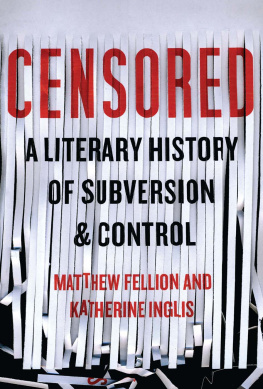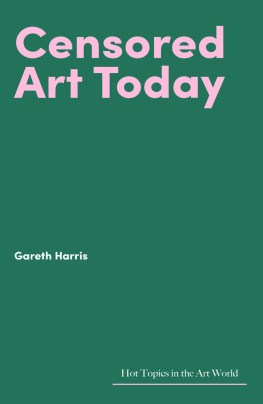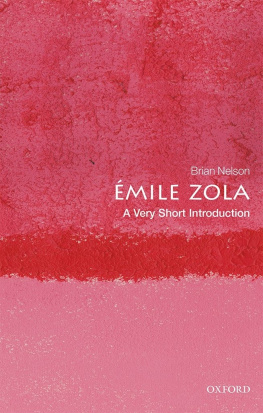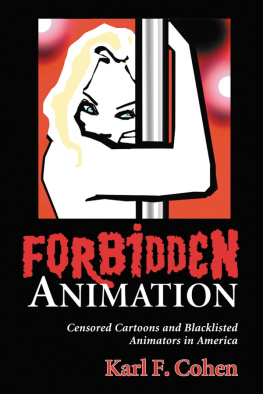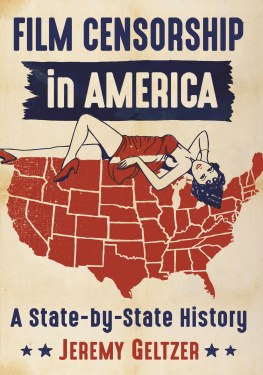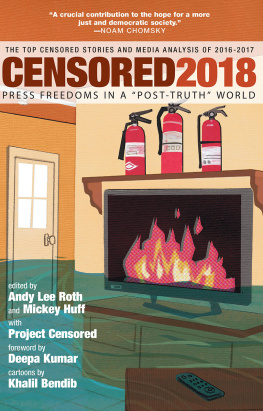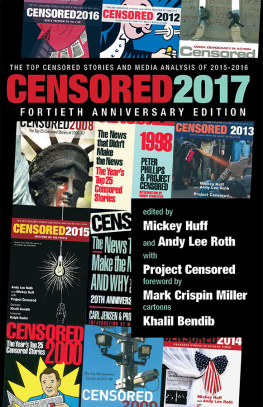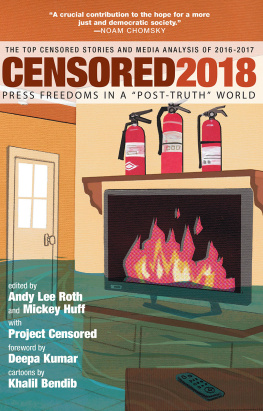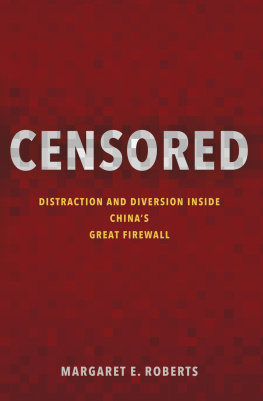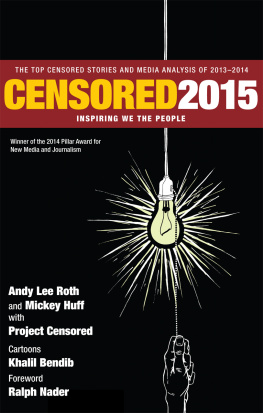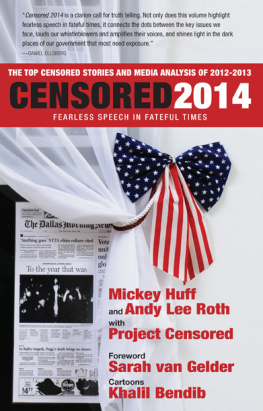
Censored
Censored
A Literary History of Subversion and Control

Matthew Fellion and Katherine Inglis
MCGILL-QUEENS UNIVERSITY PRESS
MONTREAL & KINGSTON / CHICAGO
Copyright 2017 Matthew Fellion and Katherine Inglis
ISBN 978-0-7735-5127-5 (cloth)
ISBN 978-0-7735-5188-6 (ePDF)
ISBN 978-0-7735-5189-3 (ePUB)
Legal deposit fourth quarter 2017
Bibliothque nationale du Qubec
Published simultaneously outside North America by The British Library
Printed and bound in Malta by Gutenberg Press
McGill-Queens University Press acknowledges the support of the Canada Council for the Arts for our publishing program. We also acknowledge the financial support of the Government of Canada through the Canada Book Fund for our publishing activities.
Library and Archives Canada Cataloguing in Publication
Fellion, Matthew, 1985, author
Censored : a literary history of subversion and control / Matthew Fellion and Katherine Inglis.
Includes bibliographical references and index.
Issued in print and electronic formats.
ISBN 978-0-7735-5127-5 (hardcover) ISBN 978-0-7735-5188-6 (ePDF) ISBN 978-0-7735-5189-3 (ePUB)
1. English literatureCensorshipHistory.
2. American literatureCensorshipHistory.
3. CensorshipGreat BritainHistory.
4. CensorshipUnited StatesHistory.
5. Literature and societyGreat BritainHistory.
6. Literature and societyUnited StatesHistory.
I. Inglis, Katherine, 1980, author II. Title.
Z658.G7F45 2017025.2130941C2017-902566-X
C2017-902567-8
Illustrations copyright 2017 British Library Board except for those on the page numbers listed below.
158 Fox Photos/Getty Images; 176 Gisele Freund/The LIFE Images Collection/Getty Images; 192 Keystone/Getty Images; 204 Reproduced courtesy of the National Library of Ireland; 216 Photo Gordon Parks, FSA/OWI Collection, Library of Congress, Washington, D.C. (LC-USW3-030297-D); 230 William M Gaines Agent Inc.; 248 William Jacobellis/New York Post Archives/ NYP Holdings, Inc. via Getty Images; 276 Photo courtesy Twice Sold Tales Used Books, Seattle, WA (www.twicesoldtales.com); 288 Photo Hulton Archive/Getty Images; 306 Photos Andreas Hansen; 318 Courtesy Samuel S. Lin; 338 Ronald Grant Archive/Mary Evans Picture Library; 352 Photo Uwe Anspach/dpa picture alliance archive/Alamy Stock Photo; 364 Marjane Satrapi, courtesy Penguin Random House; 382 Photo Chris Summitt
Typeset by IDSUK (DataConnection) Ltd
Jacket designed by Jason Anscomb, Rawshock Design
For those who, free to speak,
are powerless to be heard

Contents
, translated by John Wyclif, William Tyndale, and Others
by John Cleland
by Frances Burney
by Percy Bysshe Shelley
by Mary Prince
by Walt Whitman
by Mark Twain
by mile Zola
by Oscar Wilde
by Radclyffe Hall
by James Joyce
by D. H. Lawrence
by Kate OBrien
by Richard Wright
by Bill Gaines, Al Feldstein, and Jack Kamen
by Vladimir Nabokov
by Richard Neville, Felix Dennis, Jim Anderson, and Guest Editors
by Etheridge Knight and Incarcerated Men at Indiana State Prison
by James Kirkup
by Susanne Bsche
by Salman Rushdie
by Rex Feral
by Ma Jian
by Marjane Satrapi
by Gloria Anzalda

Acknowledgements
Writing a history of censorship makes one conscious of all the people who work to bring books into the world, many of whom have been on the front lines in the struggle between subversion and control. We would like to thank Rob Davies of British Library Publishing for thinking of this book, giving us the opportunity to write it, and allowing it room to grow. He has been receptive and supportive at every step. We are grateful to our editor Jon Crabb and copy-editor Jacqueline Harvey for making the text pristine (and sorry for the headaches that our endnotes will have given them), to image editors Pauline Hubner and Sally Nicholls for the illustrations, to Jason Anscomb for the visual style, as well as the typesetter, proofreader, and indexer. Thanks to Emma OBryen, Maria Vassilopoulos and Abbie Day for publicity, marketing and sales; and thanks to Natalie Blachere, Filomena Falocco, Amy Hemond, Jennifer Roberts, Jack Hannan and others at McGill-Queens University Press for marketing and distributing the North American edition. We would also like to thank the printers and everyone else involved in delivering this book into readers hands, especially the independent booksellers who continue to serve their communities despite the economies of scale.
The welcoming staff at the National Library of Scotland have made working there a pleasure, and have patiently fielded what must have seemed like endless requests for a motley selection of resources. Special thanks to Suzy Pope and Mike Saunders, Reference Services, for help in finding tabloids. Thanks, too, to the cafe staff for the coffees and teas that kept us going. The University of Edinburgh Interlibrary Loan staff, particularly Louise Dutnell, have gone beyond the call of duty in tracking down and summoning elusive books, some of which we consulted with the help of staff at the Centre for Research Collections. We are grateful to Liz Stevenson, Academic Support Librarian at the University of Edinburgh Law Library for teaching us how to navigate case law, and Shenxiao Tong, Academic Support Librarian at the Main Library, for advice. Janet Black, Gavin Douglas, and Fiona Carmichael of the University of Edinburgh created an environment for Dr Inglis to conduct secure research. Anne Marie Menta and June Can at Yales Beinecke Rare Book and Manuscript Library processed our request for and supplied us with images of papers from the James Kirkup archive. Nathalie Mathieu at Library and Archives Canada guided us to the Radclyffe Hall material in the Lovat Dickson bequest. Marie Moser, Cat Anderson, and the other lovely people at the Edinburgh Bookshop have sourced various hard-to-find books for us, including Black Voices from Prison. Robert Inglis overcame technological barriers on our behalf.
We are deeply grateful to those who read chapters of the book or otherwise made contributions: James Eli Adams, Owen Boynton, Denise Chung Guerrero, David Fellion, Holly Furneaux, Keith Hughes, Carole Jones, Michelle Keown, Michele Moody-Adams, Tom Mole, Steve Pinkerton, Cory Rushton, Shari Sabeti, Paul Sawyer, Suzanne Trill, and Jonathan Wild. Anne Marie Hagen organized a workshop that allowed us to give material on Jenny Lives with Eric and Martin an early airing. The University of Edinburgh students who have taken Dr Ingliss course on censorship have also contributed through their enthusiasm for the subject and their challenging questions. They chose to study Beloved and Persepolis, both of which appear in this book. We would like to extend special thanks to Mayra Feliciano for allowing us to use her image in , and to the photographer Chris Summitt for providing a window into community protest in Tucson. All views expressed in this book are our own, as are any errors that we have made.
Thanks, finally, to our families and friends for their support, and to everyone who has expressed interest in this project along the way. We hope you enjoy the book.
Next page
